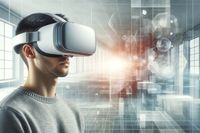Apple's Vision Pro Gets Criticized by YouTube, Netflix, and Spotify
The launch of Apple's Vision Pro is off to a rocky start as key streaming apps and its unconventional design face scrutiny.

Streaming Giants Avoid Apple's Vision Pro
Apple's upcoming mixed-reality headset, the Vision Pro, offers users an immersive experience with its AI, voice and gesture control, and spatial audio features. However, leading video and music streaming services like YouTube, Spotify, and Netflix have chosen not to develop apps for the device. Instead, YouTube suggests using the Safari web browser, while Spotify and Netflix users are expected to access the platforms through web browsers as well.
This departure from the traditional app-based integration on Apple devices marks a significant shift in the digital entertainment landscape.
Content Gap at Vision Pro Launch
The absence of YouTube, Spotify, and Netflix from the lineup of supported applications for the Vision Pro could impact its reception in the market. Apple has positioned the headset as a hub for video, gaming, and entertainment, but the lack of support from major content providers raises questions about its appeal.
While Apple's own apps for music and podcasts directly compete with Spotify's offerings, not having YouTube available is particularly notable considering it was a preinstalled app on Apple's original iPad in 2010.
Other Apps Missing from the Vision Pro Ecosystem
In addition to YouTube, Spotify, and Netflix, it appears that apps from Meta, including Facebook, Instagram, and WhatsApp, may also be unavailable on the Vision Pro. However, entertainment apps like Disney+, HBO Max, Peacock, ESPN, and Amazon Prime Video are participating in the ecosystem. Apple expects the headset's App Store to support over 1 million titles.
The absence of these popular apps raises concerns about the device's appeal and functionality for potential users.
Design Questions Surround Apple's Vision Pro
The design of the Vision Pro, resembling bulky ski goggles with an umbilical cord connected to a separate battery pack, has raised practicality and aesthetic concerns. This departure from Apple's typically sleek and wireless aesthetics may impact its overall appeal to users.
The unconventional design choices and the absence of former lead designer Jony Ive's influence raise questions about the innovation and quality of the Vision Pro.


